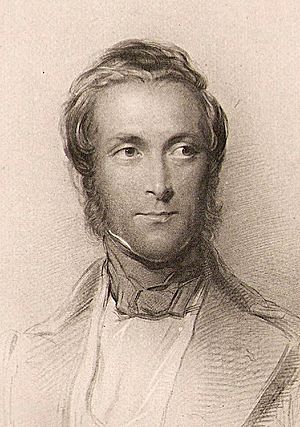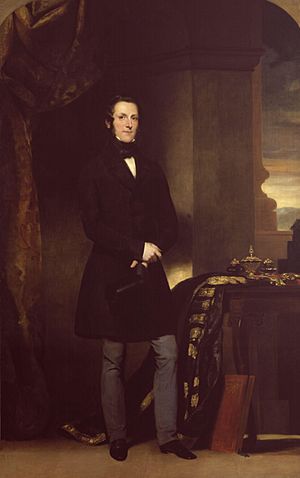James Broun-Ramsay, 1st Marquess of Dalhousie facts for kids
Quick facts for kids
The Most Honourable
The Marquess of Dalhousie
|
|
|---|---|
 |
|
| Governor-General of India | |
| Monarch | Victoria |
| Prime Minister | Lord John Russell The Earl of Derby The Earl of Aberdeen The Viscount Palmerston |
| Preceded by | The Viscount Hardinge |
| Succeeded by | The Viscount Canning |
| President of the Board of Trade | |
| Monarch | Victoria |
| Prime Minister | Sir Robert Peel |
| Preceded by | William Ewart Gladstone |
| Succeeded by | The Earl of Clarendon |
James Andrew Broun-Ramsay, 1st Marquess of Dalhousie (born April 22, 1812 – died December 19, 1860) was a Scottish leader and colonial administrator. He was known as Lord Ramsay until 1838, and then as The Earl of Dalhousie until 1849. He served as the Governor-General of India from 1848 to 1856. This was a very important role in British India.
Contents
Early Life and Education
James Andrew Broun-Ramsay was the youngest son of George Ramsay, 9th Earl of Dalhousie. His father was a general under Wellington and later served as Governor General of Canada. James spent some of his early childhood in Canada with his parents.
He later attended Harrow School in England starting in 1825. After leaving Harrow, he was taught by a private tutor. In 1829, he went to Christ Church, Oxford University. He worked hard and made many friends there. After university, he traveled in Italy and Switzerland, learning a lot and keeping a detailed diary.
Early Political Career
In 1835, James tried to become a member of the House of Commons for Edinburgh but did not win. In 1837, he was elected as a member for Haddingtonshire. The year before, he married Lady Susan Hay. She was a great support to him, and her death in 1853 deeply saddened him.
In 1838, his father passed away, and less than a year later, his mother also died. James then became the Earl of Dalhousie. He quickly became known for his speeches. In 1843, he became the Vice-President of the Board of Trade. This was an important government role dealing with business and trade.
He became the President of the Board of Trade in 1845. He worked very hard during a time when many new railways were being built. This hard work affected his health. He supported Sir Robert Peel during a debate about the Corn Laws, which were taxes on imported grain. In 1847, he accepted the important job of Governor-General of India. He agreed to take the role only if he could make his own decisions without political interference.
Governor-General of India
Dalhousie arrived in India on January 12, 1848, to begin his duties as Governor-General. He was a very dedicated worker, often working 16 to 18 hours a day. He wanted to expand the British Empire's influence in India. He saw himself as a modern leader who wanted to bring new ideas and improvements to India.
He believed in improving Indian society through modern changes. However, he often ruled with a strong hand, believing this was the best way to develop India. Some of his policies, especially the "doctrine of lapse," caused unhappiness among some Indian people. These feelings later contributed to the Indian Rebellion of 1857, which happened soon after he left India.
In 1849, under Dalhousie's leadership, the British took control of the state of Punjab. During this time, the famous Koh-i-Noor diamond was taken from the young Punjabi ruler, Duleep Singh. The diamond was considered war property and was given to Queen Victoria. It was later displayed in London. Years later, Duleep Singh tried to get the diamond back, saying it was taken unfairly.
Dalhousie also led the Second Burmese War in 1852, which resulted in Britain gaining parts of Burma.
Key Policies and Reforms
Under Dalhousie's rule, the British used a policy called the "doctrine of lapse." This policy meant that if a ruler of an Indian state died without a natural male heir, the state would become part of the British Empire. Using this policy, the British took over several states, including Satara, Jaitpur, Sambalpur, Jhansi, and Nagpur.
Another important annexation was that of Awadh. This action made Dalhousie very unpopular in the region. These and other decisions created strong negative feelings among Indian soldiers in the British Army. These feelings eventually led to the Indian Rebellion of 1857, which the British called the "Sepoy mutiny."
Dalhousie was a skilled administrator, even though he was forceful. He made many important contributions to India's development.
Improving Infrastructure
Dalhousie greatly improved communication and transportation in India. He helped build the first railway lines, which started in 1855. He also set up an imperial system of telegraphs and improved postal services, making letters cheaper and introducing postage stamps.
He encouraged private companies to help build railways for the benefit of the people. He also brought the railways under state control to ensure they served India best.
The Ganges Canal was completed during his time. This massive irrigation project, hundreds of miles long, helped farmers by providing water for their crops. This led to more food and better living conditions for many people along the canal.
Educational Reforms
Dalhousie strongly believed in creating a national education system in India. He worked to make sure that the plans for education, especially for women, were put into action. He thought that "no single change was likely to produce more important and beneficial consequences than female education." He supported women's schools, even contributing his own money to the Bethune Women's School after its founder died. He also helped pass the Hindu Widows' Remarriage Act, 1856, which allowed widows to remarry.
Civil Service Reforms
Dalhousie also reformed the civil service, which was the group of people who worked for the government. He introduced a system where people had to pass exams to get government jobs. This helped ensure that the best people were chosen for these important roles. He also made rules to prevent corruption and improve the behavior of civil servants.
Foreign Policy and Annexations
Dalhousie wanted to reduce the independence of larger Indian states. He also wanted to avoid getting involved in conflicts with foreign powers outside India. He signed a treaty with the ruler of Hyderabad in 1853. This treaty helped fund British troops who supported the ruler.
The annexation of Oudh was one of his last major actions. In 1854, he asked for a report on the condition of the province. The report gave the British a reason to act, citing "disorder and misrule." Dalhousie decided to take over the administration of Oudh, allowing the king to keep his royal title and an allowance. When the king refused to sign the agreement, the province was officially annexed on February 13, 1856. This annexation was another factor that contributed to the Indian Rebellion.
Before leaving office, Dalhousie also addressed an uprising by the Santal people in Bengal. He created a new system of administration to help maintain order and protect them from unfair landlords and moneylenders.
Return to Britain
Dalhousie left India on March 6, 1856. He was respected by many, and the British East India Company gave him a pension. However, when the "Sepoy Mutiny" (Indian Rebellion) broke out, his policies faced strong criticism. His health was poor, and he sought medical treatment in England. He died on December 19, 1860, and was buried in Cockpen.
The hill station of Dalhousie, India was established in 1854 as a summer retreat for British troops and officials. It was named after Lord Dalhousie.
Personal Life
Dalhousie had two daughters. His youngest daughter, Edith, married Sir James Fergusson in 1859. Since he had no sons, the title of Marquess became extinct when he died.
See also
 In Spanish: James Broun-Ramsay para niños
In Spanish: James Broun-Ramsay para niños



